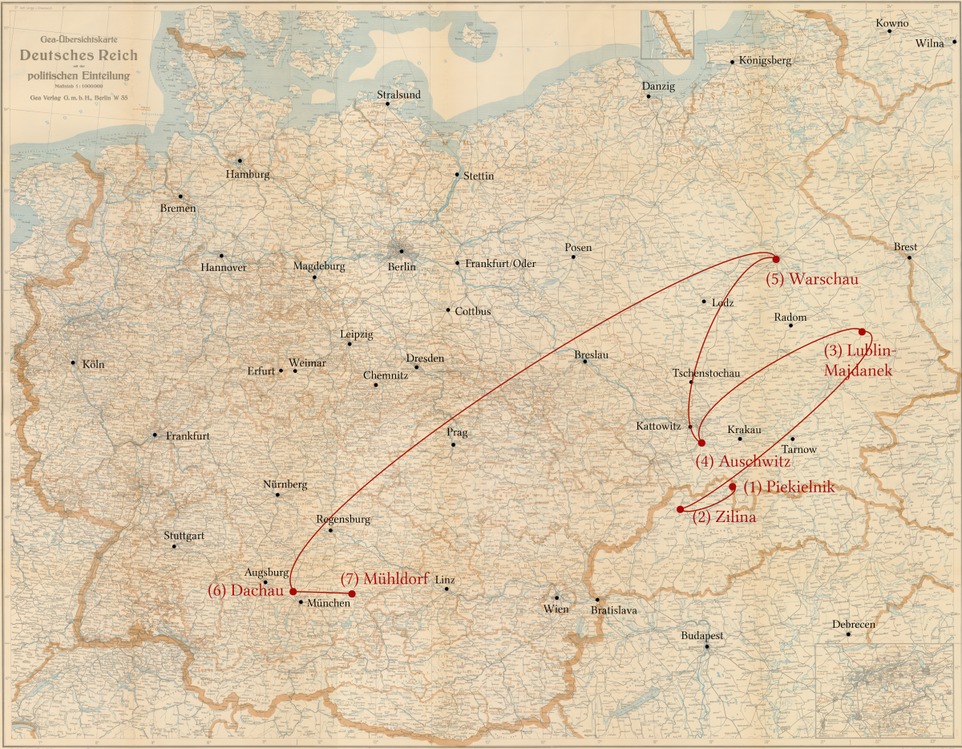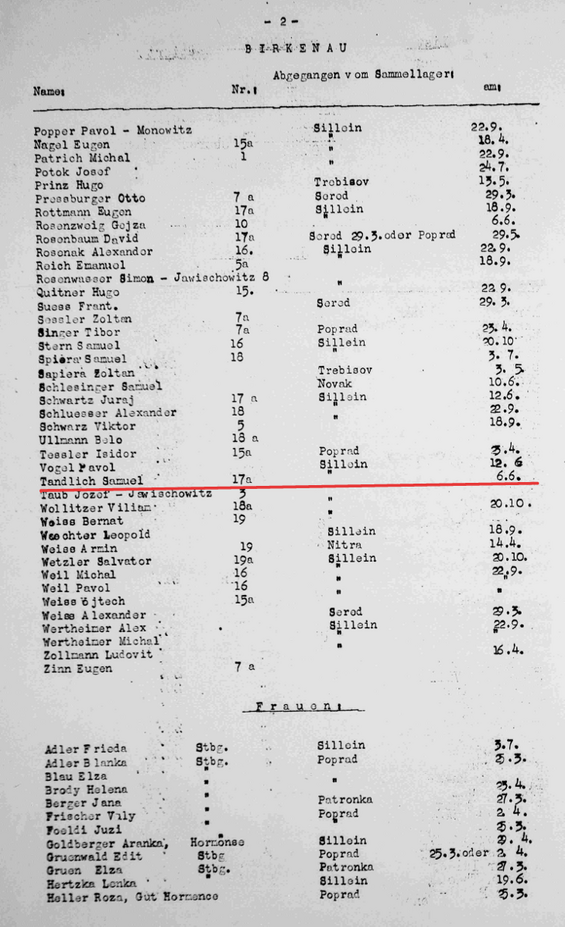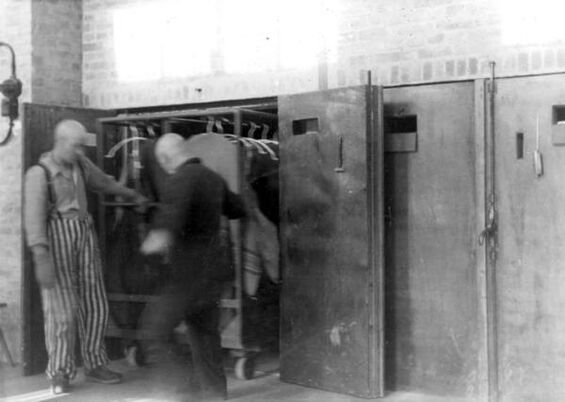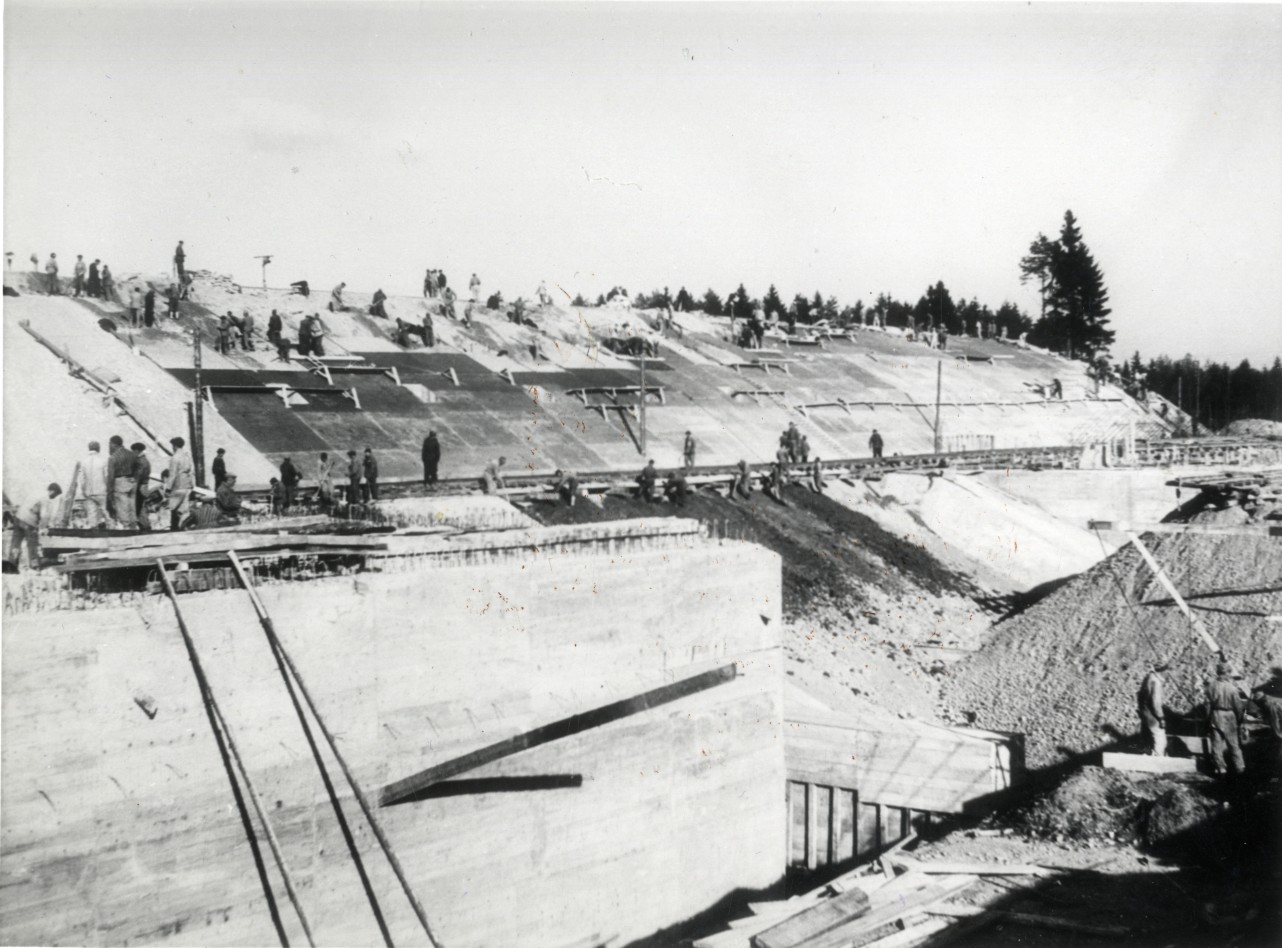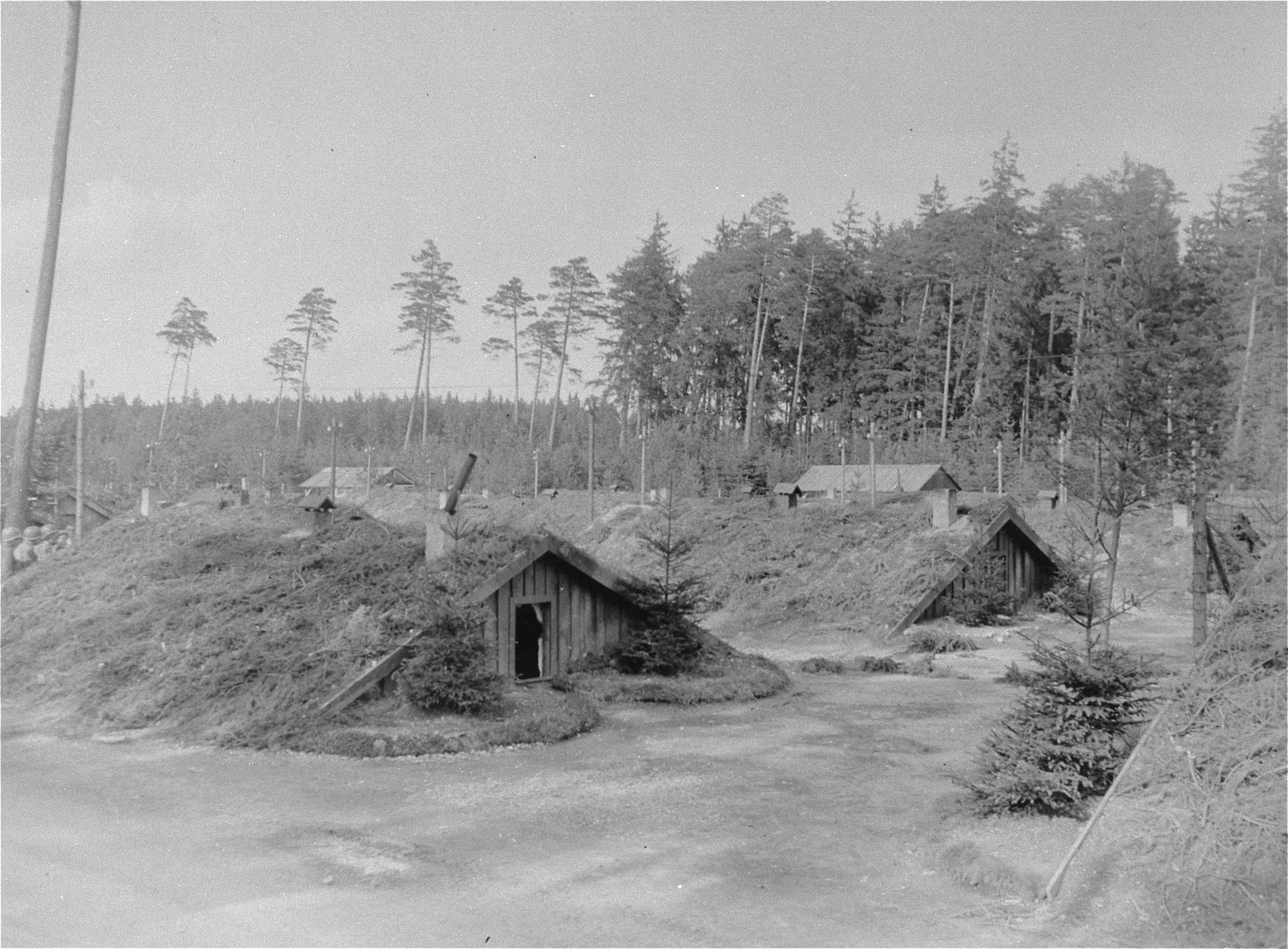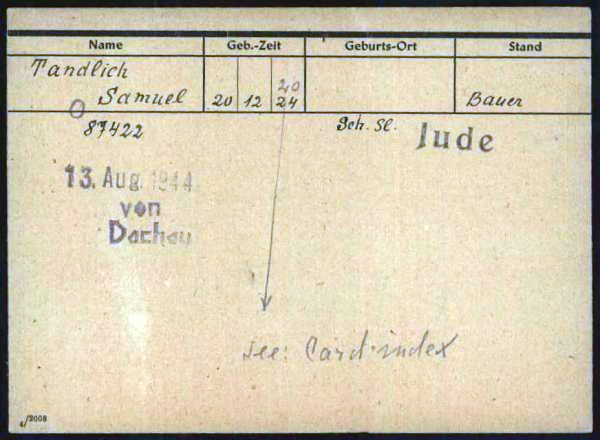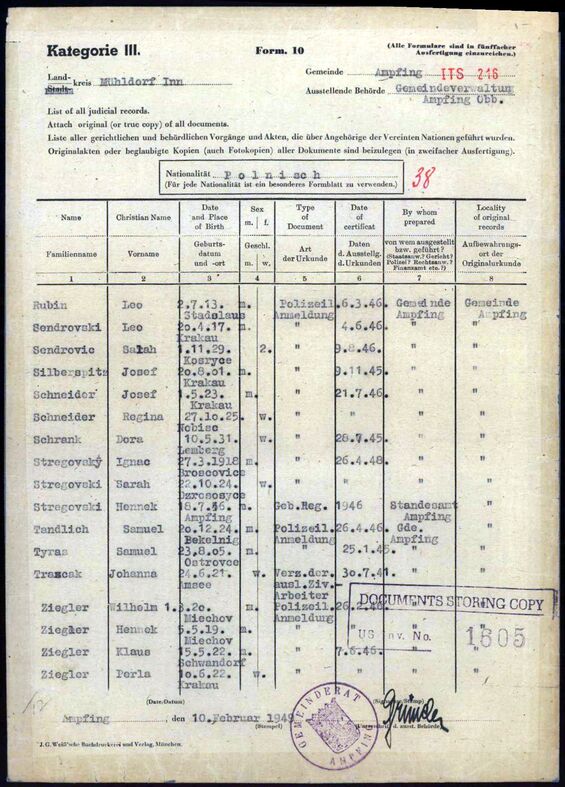The Biography of Samuel Tandlich, Piekielnik
Short biography and stations of his persecution
- born 20 December 1924 in Piekielnik/Slovakia, died 6 November 1989
- 1929 - 1934 Elementary school
- 1934 - 1939 Private tuition
- 1939 - 1941 Special agricultural school
- May 1942 Arrested, Sillein
- May 1942 to June 1942 Lublin-Majdanek concentration camp
- 30 June1942 to October 1943 Auschwitz concentration camp, prisoner number 43836
- October 1943 to August 1944 Warsaw concentration camp
- 6 Aug. 1944 Dachau concentration camp, prisoner number 87422
- 13 August 1944 Dachau concentration camp/Mühldorf subcamp
- 2 May 1945 Liberation
- 1946 to 1949 Ampfing/Mühldorf
- May/June 1949 Emigration to the USA via Bremen
Samuel Tandlich lost his parents, two brothers and two sisters in the Holocaust. His mother and sisters died in Majdanek, his father and brothers in Auschwitz. He was 21 when he was arrested,
Before the war - Piekielnik
I am making this affidavit in connection with my application for compensation for damage to body and health. Before the outbreak of persecution, I lived in Piekielnik together with my parents, my two younger brothers and my younger sisters. My home town belonged to Poland until the outbreak of the Second World War and then became part of Czechoslovakia. I was always a strong, healthy boy (I come from a wealthy and well-off family). I attended primary schools for almost five years, then my parents gave me private lessons (it was not possible for me to attend a grammar school). In 1930/1941 I attended a specialised agricultural school. My father owned large estates and was also the owner of the local restaurant and a timber merchant. We were considered wealthy people in Piekielnik. As my home town belonged to Czechoslovakia [1], I was largely spared persecution until the beginning of 1942.
Source: Unless otherwise stated: Konrad Kittl files, affidavit by Samuel Tandlich on application for compensation due to "damage to body and health", around 1965.
Notes:
- Piekielnik belonged to the Slovakian state from 1939-1945.
Silina, Maidanek
I was arrested in May 1942 and taken to Silina Prison [1]. Together with my family, we were then ...[2] ... to the Meidanek[3] concentration camp[4]. I only stayed in this death camp for a very short time. I was separated from my mother and my two sisters. I never saw them again and they perished in this extermination camp.
In May 1942, I was arrested by the Slovak Gestapo and taken to Silina prison. After two days we were put on a lorry by the Hlinka Guards and taken to the Slovakian border, where we were taken over by the German SS and taken to the Majdanek concentration camp. I was in the Maidanek concentration camp until the end of June/beginning of July 1942. The German SS commander was called Standartenfuehrer Weiss.
In Maidanek I was ordered to build barracks. There were 600 of us in a barrack and we mainly had to build barracks in Lipowa in Lublin.
Source: Landesarchiv-Baden-Württemberg, Abt. Staatsarchiv Ludwigsburg EL 350 I Bü 32700, EE Samuel Tandlich dated 14 June 1954
Notes:
- meant is Zilina/Sillein
- one line is missing
- Majdanek
- According to the file extract, the family was arrested in May by "Slovakian Gestapo and taken to the prison in Silina. After 2 days they were led to the Slovakian border
- by the Hlinka Guard (Slovakian fascists), taken from there by the German SS and taken to the Majdanek concentration camp."
Auschwitz
Together with my father and my two brothers, I was then driven to the Auschwitz concentration camp. Here my father and my brothers were torn away from me and killed. I myself was tattooed with the number 43836. I remained in this extermination camp until September/October 1943. I was put to the hardest forced labor, in Buna at the station command and later in the laundry. I fell ill with a severe case of typhus and was sent to the police station. However, I was able to escape the station. A guard who took pity on me told me to report healthy, otherwise I would be sent to the gas chambers. As I was still weakened, I was often unable to do the work that was expected of me - I had to carry loads that were far too heavy - properly and was repeatedly beaten.
Translated with DeepL.com (free version)
Anmerkung: Eine Erläuterung der Liste siehe USHMM
At the end of June/beginning of July 1942, a transport of 400 men went from Maidanek to Auschwitz. I was part of this transport. In Auschwitz I was given prisoner's clothing and the No. 43836 was tattooed on me. I lived in various blocks there, e.g. Block 5, 17a, 6 and 4a.
In Auschwitz we were always taken to construction work by the SS, mainly to Buna, where a factory was being built.
Sometimes we were also ordered to do transportation work at Auschwitz station.
Source: Landesarchiv-Baden-Württemberg, Abt. Staatsarchiv Ludwigsburg EL 350 I Bü 32700. Affidavit Samuel Tandlich dated June 14, 1954, Schaden an Freiheit.
KZ Warschau
From Auschwitz I went to Warsaw. Here we had to clear out the destroyed houses. The conditions were similar to those in Auschwitz. Many of my fellow sufferers were wasting away. I was beaten again and it was always just a question of whether I would live to see the next day.
In September/October 1943, a transport of 3000 men was sent to Warsaw. In Warsaw we were housed in a newly built concentration camp near the Pawia prison. This concentration camp was surrounded by walls and wire fences and we lived in barracks. We were one of the first transports to arrive at this concentration camp and were used to demolish the houses of the ghetto.
Source: Landesarchiv-Baden-Württemberg, Abt. Staatsarchiv Ludwigsburg EL 350 I Bü 32700. Affidavit Samuel Tandlich from June 14, 1954, Schaden an Freiheit.
| Warsaw concentration camp | |
|---|---|
| Location | Warszawa / Warsaw |
| Name | |
| Territory | General Government (1939-1945) |
| Opening | 15.08.1943 |
| Closing | At an unknown date before 01.05.1944, the concentration camp continued to operate as a subcamp of the Lublin concentration camp |
| Deportations | From 24.07.1944 to Dachau concentration camp, where the arrival was registered on 06.08.1944 |
| Prisons | |
| Gender | Men |
| Assignment of prisoners at | |
| Type of work | Removal and collection of materials resulting from the demolition of the ghetto |
| Comments | On July 19, 1943, 300 prisoners were transferred from the Buchenwald concentration camp to build the concentration camp. / The establishment of a concentration camp in Warsaw was based on Himmler's wish to remove all traces of what was once the largest Jewish community in Europe from the cityscape: the entire ghetto was to be torn down and all earth bunkers, cellars and underground canals were to be filled in. The site was then to be covered with earth and turned into a park. To this end, the SS-WVHA had a labor camp set up on the former ghetto site from July 1943. The prisoners were transferred from Buchenwald and Auschwitz to Warsaw. The concentration camp continued to operate as a subcamp of the Lublin-Majdanek concentration camp from spring 1944. Around 2,500 concentration camp prisoners and 1,000 Polish workers were deployed for over a year to demolish the buildings and raze the site to the ground. From July 24, 1944, the prisoners were mainly "evacuated" to Dachau concentration camp.</td |
| Source: deutschland-ein-denkmal.de | |
Dachau and Mühldorf
In the late summer of 1944, we were driven from Warsaw to Dachau, where I only stayed for a short time. Then I was sent to the Muehldorf forest camp. Despite my miserable condition - I was just a skeleton - I had to work hard. When I was liberated, I was a completely broken person, both physically and mentally.
At the end of July/beginning of August 1944, I was deported to Dachau with a transport of about 4000 men. First we marched to Kutno for three days, then we were taken to Dachau in a truck train. In Dachau I was given the prisoner number 87422, but I was only there for a week and was then sent to the Muehldorf forest camp near Dachau. This camp was also surrounded by wire fences and guarded by SS men. At first we lived in tents, later in bunkers, and there were about 30 of us in one bunker. I was assigned to tunnel construction there and had to operate a crane.
We were liberated by American troops on May 2, 1945.
Source: Landesarchiv-Baden-Württemberg, Abt. Staatsarchiv Ludwigsburg EL 350 I Bü 32700 EE Samuel Tandlich from 14.6.1954
After the War: 1946-1949 Ampfing
I was immediately treated by doctors from the US Army. I can no longer remember individual names. I stayed here until June 1949 and was treated as an outpatient by UNRRA and IRO doctors. I can no longer remember individual names. Please ask the IDE for the documents. I still suffer from severe health problems as a result of the persecution. The loss of my whole family, the years spent in the extermination camps, the constant fear of death, the hard work under miserable conditions have made me a mentally disturbed person. I am under constant medical treatment. I declare that I am willing to be examined by a commission of trusted doctors. I confirm the accuracy of my statement by signing it in lieu of an oath.
The Witness Ignatz Katz
The witness Ignatz Katz, born on September 4, 1921 in Cologne, named by Samuel Tandlich, confirmed his detention information. He himself was detained in: August 1941 - September 1942 ZAL Novaky (coal mines), September 1942 - October 1943 KZ Auschwitz, October 1943 - June 1944 Warsaw concentration camp, June 1944 - July 1944 Dachau concentration camp, July 1944 - May 2, 1945 Dachau/Mühldorf concentration camp. After the war, he was in the DP camp in Feldafing from 5/1945 to 1/1948. He emigrated to the United States.
His experiences are described in an expert report from 1956:
The patient was interned in the ghetto from 1941 to 1942 and subsequently in various concentration camps until the liberation in 1945. In the Auschwitz concentration camp, the patient was responsible for maintaining order in a barrack that was mainly occupied by adolescents. Because of some offense, the patient was ordered to pour cold water over these adolescents in the winter. Since he refused to carry out this order, this punishment was not only carried out by the Ukrainians on the other adolescents, but the
patient himself had to undress naked, was doused with cold water in the cold weather and had to remain standing outside for about three hours. The next day he was transferred to a penal commando and for a period of one month was taken to a bunker after work in the evening, where he had to spend the night standing because there was no room to lie down. [...] Later, the patient was sent to Warsaw, where he had to do cleanup work. Here, some coins were discovered on him that he had found during this work, and as a punitive measure, he was hung up by his hands, which were tied behind his back, for about an hour, until he lost consciousness.
Source: Ignatz Katz file, Landesamt für Finanzen, Landesentschädigungsamt, München, Afile reference BEG31065
Anmerkungen
Further Sources
-----
Office for Compensation
Stuttgart, AZ. ES 8320, 1965-1968
Notes
Last update:
27 February 2025: Added descriptions by Ignatz.
28 February 2025: Date changed, 30 June 1943 Start of detention in Auschwitz, see link.
Picture Credits
- Liste von aus der SLOVAKEI Deportierten, Name List ID: 21840, United States Holocaust Memorial Museum
- Birkenau, Poland, 1942, Prisoners working in the disinfection cabin. Yad Vashem, Album Number FA157/374
- Auschwitz, Poland, Unloading the trains at the central train station. Yad Vashem, Archival Signature 5720/40
- Stadtarchiv Mühldorf
- Barracks in Waldlager VI, near Ampfing. United States Holocaust Memorial Museum, Photo Number: #80112
- Individuelle Häftlings Unterlagen - KL Dachau 1.1.6.2/10334247/ITS Digital Archive, Arolsen Archives
- Individuelle Häftlings Unterlagen - KL Dachau 1.1.6.2/10334248/ITS Digital Archive, Arolsen Archives
- Listen von Angehörigen der Vereinten Nationen, anderer Ausländer, deutscher Juden und Staatenloser 2.1.1.1/70030911/ITS Digital Archive, Arolsen Archives
- Schriftwechsel und Namenlisten, ausgestellt in Bremen-Grohn: Verkehrsmittel Schiff (USS GENERAL HAAN, USS GENERAL HOWZE); Transitländer und Emigrationsziele: Kanada, USA 3.1.3.2/81659583/ITS Digital Archive, Arolsen Archives
